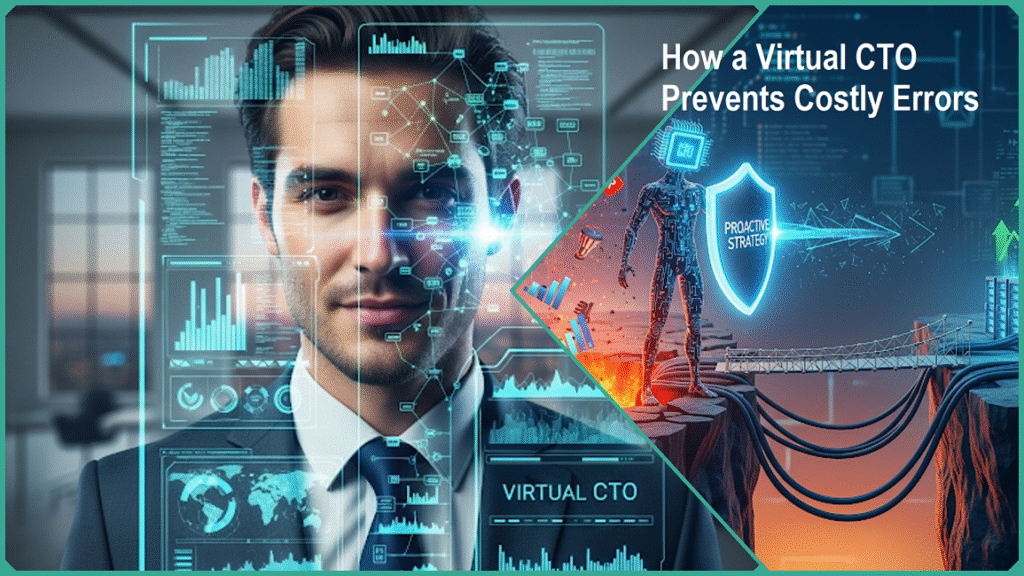How a Virtual CTO Prevents Costly Errors: Expert Insights
Estimated reading time: 19 minutes
Technology serves as the essential foundation fueling business growth and success in today’s rapidly evolving landscape. Effectively managing IT investments, cybersecurity, and digital transformation strategies is key to safeguarding your company’s future. For business owners, founders, and executives, one wrong technology decision can lead to costly overspending, significant security vulnerabilities, or missed opportunities that might have driven faster growth.
Despite the pressing and urgent need for strong technological leadership, many organizations find themselves struggling due to limited financial resources or inconsistent and fluctuating demands. These challenges often make it impractical or even impossible to justify hiring a full-time Chief Technology Officer (CTO) to oversee and manage these crucial and highly important areas effectively.

Introducing the Virtual CTO—a highly flexible and cost-effective solution that has been widely embraced by innovative businesses across the globe. Whether you are a business leader looking to avoid costly mistakes or an aspiring tech consultant eager to increase your professional value, gaining a clear understanding of how a Virtual CTO (vCTO) can help prevent expensive errors is essential.
This role not only offers strategic technology guidance and expert advice but also plays a crucial part in ensuring that your business operations run smoothly, efficiently, and without unnecessary interruptions. Optimizing processes and implementing effective solutions helps save you a significant amount of time and valuable resources over the long term, ultimately contributing to the sustained success and growth of your business.
What Is a Virtual CTO?
A Virtual CTO (Chief Technology Officer) is a seasoned technology leader who provides executive-level technical expertise, leadership, and strategic guidance on a flexible, remote, and part-time basis. Unlike a traditional full-time CTO employed by a single company, a virtual CTO serves multiple businesses, tailoring their involvement as needed without the significant overhead costs of a full-time executive.
This arrangement enables companies—especially startups, small to medium enterprises (SMEs), and organizations with limited budgets—to access top-tier technology leadership without incurring the expenses tied to a full-time CTO salary, benefits, and bonuses. Virtual CTOs bring a wealth of experience across industries and projects, allowing them to quickly integrate into diverse business environments and offer objective, strategic technology solutions.
Key Functions of a Virtual CTO
- Strategic Tech Planning: They carefully develop comprehensive long-term technology roadmaps that are closely aligned with overarching business objectives, ensuring that every technology investment made contributes significantly to driving meaningful and measurable business outcomes. This thoughtful planning process helps organizations stay ahead in a rapidly evolving technological landscape while maximizing the return on their technology investments.
- Budgeting & Cost Control: Virtual CTOs play a crucial role in optimizing IT spending by carefully analyzing and managing expenses. They help businesses avoid unnecessary costs by identifying redundant or inefficient expenditures and ensuring that resources are allocated most effectively and strategically as possible. This proactive approach enables companies to maximize their IT budgets while supporting their overall business goals.
- Cybersecurity Oversight: They develop and implement comprehensive and robust cybersecurity policies and frameworks designed to safeguard the company against the ever-evolving landscape of digital threats. Their efforts ensure that the organization not only remains protected from potential cyber-attacks but also consistently meets and adheres to all relevant regulatory compliance requirements and industry standards.
- Vendor & Software Selection: Serving as an impartial and objective advisor, a virtual CTO thoroughly evaluates and carefully selects the most appropriate technology vendors and software solutions that are perfectly aligned with the company’s unique and specific requirements. This process ensures that the chosen options not only meet current business needs but also support future growth and scalability.
- IT Team Mentoring: They actively support and significantly elevate the capabilities of in-house technical teams by providing expert guidance, strong leadership, and comprehensive skills development opportunities. This approach helps foster growth, improve team performance, and build a more cohesive and proficient technical workforce.
- Future-Proofing: A virtual CTO designs and implements scalable and highly resilient IT infrastructures that are capable of evolving and adapting continuously to meet the changing needs and growth of the business over time. This approach ensures that the technology framework remains robust, flexible, and prepared for future challenges and opportunities as the company expands and transforms.
By leveraging the expertise of a virtual CTO, businesses gain valuable access to seasoned technology leadership that expertly balances the critical aspects of innovation, cost management, and risk reduction—thereby enabling more informed and strategic decision-making while effectively safeguarding the company against costly operational errors and technological pitfalls.
This highly flexible and adaptable model also empowers businesses to efficiently scale their technology leadership resources up or down in response to evolving business needs and market conditions, making it an exceptionally well-suited and practical solution for dynamic, fast-paced, and ever-changing business environments.
Why Costly Technology Errors Happen
Costly technology mistakes are unfortunately widespread, especially among organizations lacking dedicated in-house technology leadership or a clear strategic oversight framework. Such errors often lead to substantial financial losses, major operational disruptions, and impeded business growth. Below are some key reasons why these expensive mistakes happen so frequently:
- Overspending on unnecessary or unsuitable tech solutions: Businesses frequently fall into the trap of buying expensive software or hardware that doesn’t really fit their actual needs. This can happen when they are influenced by aggressive sales tactics or fail to thoroughly evaluate alternatives. The result is inflated budgets spent on tools that provide little return or complicate workflows.
- Implementing systems that conflict with business needs: Choosing technology without aligning it to the company’s goals and processes causes inefficiencies and resistance from users. For example, deploying a complex CRM that the sales team finds cumbersome can reduce productivity rather than enhance it.
- Falling prey to security breaches and non-compliance fines: Lack of expertise in cybersecurity leads to vulnerabilities. Many businesses neglect updates, backups, and regular security audits. This opens the door to cyberattacks that can cost millions in damages, lost reputation, and regulatory fines.
- Delayed project delivery due to poor planning: Without a clear technology roadmap and project management discipline, IT initiatives often miss deadlines, blow budgets, or fail to meet objectives. Haphazard implementation creates cost overruns and missed market opportunities.
- Choosing vendors based on marketing hype rather than fit or value: Businesses sometimes select technology partners because of impressive sales pitches or brand names without rigorous vetting. This often leads to vendor lock-in with expensive contracts, subpar service, or scalability issues.
The root causes of these errors usually boil down to insufficient strategic oversight, limited technology expertise, and a lack of objective analysis. Organizations without a seasoned technology leader risk making decisions based on incomplete information or internal biases rather than business-driven criteria.
By contrast, a Virtual CTO brings the necessary experience and strategic lens to guide these decisions effectively. They conduct thorough needs assessments, develop aligned technology roadmaps, enforce rigorous vendor evaluation, and advocate for robust cybersecurity measures—all critical to preventing these costly errors and safeguarding business success.
Supporting insights from recent research and expert observations highlight that companies frequently experience cost overruns, security lapses, and inefficiencies due to outdated hardware/software, poor planning, and weak backup or disaster recovery plans.
Businesses are strongly encouraged to adopt proactive and strategic technology management practices, including conducting thorough and regular auditing processes, as well as seeking expert advice and guidance. By implementing these comprehensive measures, companies can effectively circumvent a wide range of common pitfalls and significantly reduce potential risks that could otherwise impact their operations and growth.
How a Virtual CTO Prevents Costly Errors
Discover how strategic technology leadership serves as your strongest defense against costly business mistakes. Explore expert insights into how a virtual CTO’s guidance—from infrastructure planning to vendor selection—empowers your company to make smarter, more profitable technology decisions and safeguard your future.
Strategic Technology Roadmap
A Virtual CTO (vCTO) conducts a comprehensive evaluation of a company’s current technology infrastructure, business objectives, and future growth plans. Using this detailed analysis, the vCTO crafts a technology roadmap that aligns IT investments with overarching business goals. This careful alignment ensures businesses avoid unnecessary expenditures on misaligned or redundant technologies, preventing costly rework and wasted resources.
As highlighted by industry experts, “A virtual CTO translates business objectives into technology roadmaps, preventing misaligned investments and avoiding future rework.” This strategic foresight helps companies invest only in technology that drives measurable, long-term value, steering clear of pitfalls common to businesses lacking strategic oversight.
Vendor & Solution Vetting
Choosing the wrong vendors or software due to aggressive sales tactics or a lack of objective evaluation is a frequent source of costly errors. Virtual CTOs bring impartiality to this process, conducting rigorous due diligence including product comparisons, contract negotiations, and performance assessments.
By objectively evaluating options, a vCTO ensures the company selects technology solutions that fit its specific needs, budget, and scale. This prevents vendor lock-in and costly technology mismatches, enabling better scalability and agility as the business evolves.
Cost Control & Budget Optimization
Virtual CTOs meticulously monitor and optimize IT budgets. Rather than succumbing to the allure of every new “shiny” technology, vCTOs identify right-sized solutions that fit current needs while allowing for future scaling. They also uncover hidden or unnecessary costs, such as unused software licenses or oversized cloud resources, and recommend ways to reduce waste.
Research shows that companies can save significantly by cutting excess software licenses and resizing cloud infrastructure, with virtual CTOs playing a critical role in these optimizations. The outcome is a strategic allocation of technology spending designed to maximize return on investment and empower business growth.
Cybersecurity & Compliance Management
The consequences of cybersecurity breaches are severe—ranging from hefty fines to irreversible reputational damage. A virtual CTO is instrumental in safeguarding the business by building and auditing robust cybersecurity frameworks.
They implement best practices such as multi-factor authentication, least-privilege policies, regular security audits, and employee training to mitigate risks. vCTOs also ensure compliance with regulatory requirements like GDPR, HIPAA, or SOC 2, thus avoiding costly penalties and legal complications.
Efficient Product Development
For startups and companies focused on delivering tech products, a Virtual CTO streamlines software development and product management processes. They guide tech stack choices to prevent costly technical debt, enforce agile methodologies, and oversee project timelines and budgets.
This guidance reduces delays and cost overruns, ensuring timely product delivery aligned with business goals. The strategic involvement of a vCTO in development decision-making substantially lowers the risk of product failure and costly rework, critically contributing to the startup‘s growth trajectory.
In Summary
A Virtual CTO’s extensive expertise spans the entire spectrum of technology strategy, budgeting, cybersecurity, vendor management, and development leadership. Their proactive involvement plays a crucial role in preventing costly mistakes by ensuring that technology initiatives are closely aligned with overarching business goals, effectively managing and controlling expenses, safeguarding critical digital assets, and promoting highly efficient operational processes.
This unique dual focus on both strategic alignment and operational excellence is precisely what makes the virtual CTO an indispensable and invaluable asset for businesses aiming to maximize the return on their technology investments while simultaneously minimizing risks, reducing waste, and optimizing overall performance.
Real-World Example: Avoiding a Six-Figure Mistake
Here’s a compelling and insightful real-world example that demonstrates how a skilled Virtual CTO can effectively intervene to prevent a potentially devastating and extremely costly six-figure error from occurring, saving the company from significant financial loss and operational disruption:
A fast-growing SaaS startup was on the verge of signing a $200,000 contract for an enterprise-grade Customer Relationship Management (CRM) system. The decision was heavily influenced by aggressive vendor sales tactics promising a comprehensive solution packed with features. However, the startup’s internal assessment was rushed and lacked the perspective of a seasoned technology leader.
When a Virtual CTO was brought in for an objective review, they conducted a thorough analysis of the startup’s sales processes, user needs, and growth expectations. The findings were eye-opening: the startup would realistically utilize only about 15% of the CRM’s features. Most of the system’s capabilities were either unnecessary or too complex for the team, which risked low adoption and wasted investment.
Leveraging their expertise, the Virtual CTO recommended an alternative CRM solution that was more affordable, scalable, and better suited to the company’s current and projected needs. This tool provided the essential features needed without the bloat and hefty price tag.
The result?
By switching to the recommended solution, the startup cut CRM-related costs by approximately 70%, equating to savings exceeding $140,000. Additionally, user adoption dramatically improved because the solution was simpler and more aligned with the team’s workflows. The reduction in costs and enhanced efficiency provided the startup with more capital and agility to invest in other critical growth areas.
This case illustrates the transformative role a Virtual CTO plays by applying unbiased, expert leadership to prevent costly technology errors. Without their intervention, the startup likely would have committed a significant budget to an ill-fitting system that hindered productivity and strained finances—an all-too-common scenario in tech decision-making without expert oversight.
Key Benefits of a Virtual CTO
Here is a detailed and clear comparison table that highlights the key benefits of a Virtual CTO in contrast to a Full-Time CTO, drawing from extensive industry insights and numerous real-world cases and experiences:
| Benefit | Virtual CTO | Full-Time CTO |
|---|---|---|
| Cost Efficiency | Pay-as-you-go, contract flexibility, no benefits or overheads. Lower total cost for SMEs and startups. | Fixed salary plus bonuses, benefits, office space, and other overheads. Higher ongoing expenses. |
| Access to Expertise | Brings broad, industry-wide experience from working with multiple companies and diverse sectors. | Depth of knowledge focused on a single company, often limited to one industry or environment. |
| Flexibility | Part-time, project-based, or interim engagement. Scales with business needs and projects. | Full-time with fixed hours and responsibilities, less adaptable to fluctuating business cycles. |
| Objective Perspective | Offers an unbiased, external viewpoint unaffected by internal politics or culture. | It may be influenced by internal company politics and culture, which can affect decision-making. |
| Scalability | Easily adapts role and involvement as the business grows or pivots without requiring restructuring. | Requires formal restructuring or additional hires to adjust scope and scale with business changes. |
| Risk Reduction | Lower commitment risk, easier and less costly to change or terminate the contract. | Longer-term commitment with higher termination costs and complexity. |
This comparison highlights why many startups, SMEs, and businesses seeking agile technology leadership prefer a Virtual CTO. The flexibility, cost savings, and diverse expertise offered by a Virtual CTO make it a highly attractive model for companies that want high-level technical direction without the full-time commitment. Conversely, larger businesses with complex needs and permanent technology teams may find a full-time CTO better suited for their continuous, integrated leadership requirements.
Choosing between these options depends on your company’s size, budget, growth stage, and the complexity of your technology environment. Many organizations start with a Virtual CTO to gain strategic guidance early and possibly transition to a full-time CTO as their technology needs mature and solidify.
Essential Virtual CTO Skills & Qualities
Aspiring Virtual CTOs need a balanced mix of technical expertise, strategic vision, leadership ability, and business acumen to excel in bridging technology and business goals. Here are the must-have soft and hard skills for a successful Virtual CTO:
- Technology Strategy: Ability to align IT initiatives tightly with business objectives by creating forward-looking technology roadmaps. This involves understanding emerging technology trends like cloud computing, AI, and cybersecurity, and applying them to drive innovation and competitive advantage.
- Financial Acumen: Skills in budgeting, cost control, and ROI assessment enable the Virtual CTO to allocate resources wisely and demonstrate the business value of technology investments.
- Risk Management: Understanding and mitigating both cybersecurity threats and operational risks is critical. A vCTO must build robust security frameworks and ensure compliance with data protection regulations (e.g., GDPR, HIPAA).
- Leadership & Communication: A Virtual CTO must translate complex technical concepts into clear, business-friendly language. They lead teams through mentorship, foster collaboration, and build trust with C-suite executives and stakeholders.
- Vendor Management: Possessing strong negotiation skills combined with effective relationship management abilities enables a vCTO to secure highly favorable contracts, efficiently manage vendor performance, and successfully avoid costly lock-ins that could impact the organization’s budget and operational flexibility. These skills are crucial in maintaining productive and mutually beneficial partnerships with vendors over time.
- Staying Current: The tech landscape evolves rapidly. vCTOs commit to continuous learning and adaptability, keeping abreast of new technologies, methodologies, and regulatory changes to keep their businesses ahead of the curve.
Additional critical skills include project management to oversee delivery timelines and budgets, and innovation management to foster a culture of continuous improvement. Balancing deep technical knowledge with strategic foresight and interpersonal skills distinguishes an effective Virtual CTO and positions them to deliver maximum value.
This broad yet deep skill set empowers Virtual CTOs to operate highly effectively across a wide range of industries and various business sizes, from startups to large enterprises. By leveraging their expertise, they can successfully mitigate potential risks and strategically steer technology initiatives in ways that consistently drive and support sustainable, long-term business growth and innovation.
Latest Trends in Virtual CTO Services
As technology and business environments continue to evolve at an increasingly rapid pace, Virtual CTO services are continuously adapting and expanding to effectively meet the shifting and diverse needs of startups, small and medium-sized enterprises (SMEs), and even larger, more established corporations.
In this dynamic climate, here are some of the most significant and latest trends that are currently shaping and defining Virtual CTO offerings in the year 2025:
- Fractional Leadership: More startups and small to medium-sized enterprises prefer fractional CTOs, engaging them on a part-time or project-specific basis instead of hiring full-time CTOs. This approach offers cost efficiency and flexibility while accessing high-level expertise as needed.
- Remote-First Operations: Virtual CTOs are leveraging remote collaboration tools, cloud platforms, and digital workflows to seamlessly integrate with distributed teams. This remote-first model ensures continuous support without geographical constraints, making it easier to engage global talent and provide real-time guidance.
- Cybersecurity Focus: With cyber threats escalating globally, there is an increasing demand for Virtual CTOs who prioritize security and regulatory compliance. vCTOs help companies build robust cybersecurity strategies, implement threat detection, and stay compliant with evolving data protection laws such as GDPR, HIPAA, and others.
- AI & Automation Integration: Virtual CTOs are helping businesses leverage artificial intelligence and automation technologies to gain a competitive advantage. From automating routine processes to integrating AI-driven analytics, vCTOs guide the adoption of these transformative technologies while managing associated risks.
- Project-Based Engagements: Companies increasingly hire vCTOs for specific initiatives such as digital transformation programs, new product launches, cloud migrations, or technology stack upgrades. This trend highlights the role of vCTOs as strategic partners who provide focused expertise to accelerate key projects and maximize ROI.
Additional trends include increased emphasis on cloud and multi-cloud strategies, edge computing adoption, and the use of advanced DevOps and MLOps pipelines to accelerate development cycles. Virtual CTOs are also increasingly harnessing generative AI tools to enhance software delivery, risk management, and decision-making support.
In Summary
The 2025 Virtual CTO landscape is characterized by remarkable flexibility, forward-thinking strategic security leadership, and the proactive enablement of cutting-edge technology innovation. These qualities make virtual CTOs indispensable partners who play a crucial role in driving sustainable business growth and enhancing organizational resilience amid a constantly shifting environment filled with rapidly evolving challenges and emerging opportunities. Their ability to adapt and lead technology strategies ensures businesses remain competitive and future-ready in an increasingly complex digital world.
FAQs
How does a Virtual CTO differ from a traditional technology consultant?
A Virtual CTO provides ongoing, hands-on leadership and takes ownership of your entire technology strategy. They work as part of your leadership team, ensuring alignment with business goals and delivering long-term outcomes. In contrast, traditional technology consultants typically offer guidance or advice on specific projects without managing execution or strategic direction.
Is hiring a Virtual CTO cost-effective for small businesses?
Virtual CTOs work on a part-time, retainer, or project basis—so you pay only for the expertise you need when you need it. This model is far more affordable than retaining a full-time CTO with salary, benefits, and overhead costs.
Can a Virtual CTO help with cybersecurity and compliance?
Virtual CTOs build and audit cybersecurity frameworks, implement best practices, provide staff training, and monitor for threats. They also ensure compliance with regulations like GDPR or HIPAA, significantly reducing security risks and potential regulatory fines.
What should I look for when hiring a Virtual CTO?
Seek a candidate or firm with a proven track record of aligning technology with business strategies, strong communication skills, experience managing risks, and positive references or case studies from past clients. Compatibility with your company culture and a clear understanding of your industry are also critical.
How quickly can a Virtual CTO make an impact?
Many Virtual CTOs perform rapid technology assessments and deliver actionable recommendations within a few weeks. This quick turnaround is especially valuable during digital transformations, before major IT investments, or when urgent risk management is needed.
In Conclusion
Choosing a Virtual CTO is a strategic investment that safeguards businesses from costly errors in IT infrastructure, cybersecurity, and growth planning. The vCTO model combines flexibility, wide-ranging expertise, and an objective perspective to deliver proven cost savings and enhanced technology leadership.
For business leaders, engaging a Virtual CTO offers a reliable path to digital resilience, optimized technology spending, and better-informed strategic decisions. For aspiring tech consultants, developing the skills required to excel as a Virtual CTO provides a powerful opportunity to create significant business impact and advance your professional journey.
Key Recommendations:
- For Business Leaders: If you lack a dedicated technology leader on your team, consider partnering with a trusted Virtual CTO before making any major technology investments or transformations. Their guidance can prevent expensive missteps and align technology efforts with your business goals.
- For Aspiring Virtual CTOs: Prioritize developing strong strategic thinking, financial insight, and communication skills alongside your technical expertise. These capabilities are essential to effectively bridge technology and business, deliver value, and lead with confidence.
Ultimately, prevention is always more cost-effective—and smarter—than remediation. A Virtual CTO is your expert partner in ensuring every technology dollar is spent wisely, risks are minimized, and your IT strategy fuels sustainable business growth. This proactive approach empowers businesses to thrive in increasingly complex and fast-moving digital landscapes.
Discover more from Skill to Grow
Subscribe to get the latest posts sent to your email.






